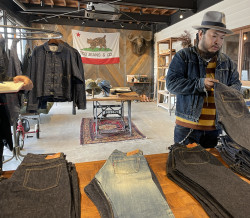
March 4, 2010
Pierre-Auguste Renoir
A major Impressionist is thrown into sharp focus at the NACT
By Metropolis
Originally published on metropolis.co.jp on March 2010

Dance at Bougival, 1883, oil on canvas, 181.9 × 98.1cm
2009 Museum of Fine Arts, Boston
“Suteki (beautiful) ! ” the young mother cries, dangling her one-year-old infant in front of Renoir’s feathery portrait Girl in a Lace Hat (1891). I guess this is how artistic taste is formed here in Japan, where the French Impressionist painter is incredibly popular.
“Renoir: Tradition & Innovation” at the National Art Center Tokyo (NACT) provides yet another opportunity to reinforce Japan’s obsession with the Impressionists, focusing on an artist who, despite considerable merits, is probably one of the most overrated individuals to ever push a brush.
But first let me say that this is an excellent exhibition. There is a wide selection of portraits, nudes, landscapes, and still lifes–nearly 80 in all, including paintings from Boston Washington and Paris. Considerable efforts have been made to give the painter’s story a fresh twist, including a daring attempt to show how retro the supposedly avant-garde artist was by pointing out his debt to 18th-century Rococo and pastoralist painting. Also, the exhibition is largely bilingual, both with regard to the copious information plates and the catalog.
The NACT is certainly taking its role as an international art venue seriously. In fact, this is such a pleasing exhibition that I almost felt my deep-seated antipathy toward the painter melting slightly. But thankfully, for the benefit of my bile ducts, the selection also includes plenty of examples of Renoir’s trademark big, buxom nudes: Young Girl with a Hat (1910) looks like the kind of lass I’d like to see in the scrum of my national rugby team next time we go up against the All Blacks, while for those who have wondered what a female sumo wrestler might look like without her mawashi, go no further than the imposing Seated Bather (1914).

Young Woman Bathing, 1888, oil on canvas, 81.3 × 65.4cm
Pola Museum of Art
Even parental love seems powerless to salve the painter’s brush. Portrait of Claude Renoir (1902), a painting of the artist’s son as a baby, shows a bulbous-headed, blackpits-for-eyes creature, which scarily evokes Marlon Brando circa Apocalypse Now.
But, on a good day and with the right subject in front of him, Renoir was also capable of great beauty. In particular, he had an unrivalled knack for depicting soft, dappled sunlight, as in the serene The Apple Seller (ca. 1890), showing the artist’s family in an idyllic pastoral setting. He could also do justice to the female form–especially when she was paying, as in the elegant portrait Madame de Bonnieres (1889), whose subject looks absolutely nothing like the flesh-toned Incredible Hulks that inhabit so many other canvases.
However, the star of the show is undoubtedly Dance at Bougival (1883), a large work showing a couple dancing, distinguished by a masterly use of color and an interesting tale. In this scene, Renoir uses bright colors for dramatic emphasis. The yellow of the young lady’s belt and the man’s hat and shoes has the effect of subtly entwining the couple, while the red trimmings on the dress and bonnet create a sense of the girl’s rising excitement as the man presses her tightly towards him.
The girl has been identified as Suzanne Valadon, an 18-year-old model who had love affairs with several of the famous painters of the time, including Renoir and Edgar Degas. In the same year as the painting, she gave birth to a baby. The story goes that she took it to the two possible fathers, but Renoir denied the child saying, “He can’t be mine, the color is terrible!” while Degas reportedly said, “He can’t be mine either, the form is terrible!” Eventually, a lesser art ist called Utrillo offered to give the baby his name, saying, “I would be glad to put my name to the work of either Renoir or Degas.” Suzanne herself later became a well-known artist, while the baby went on to become the famous painter of Parisian street scenes, Maurice Utrillo.
The National Art Center, Tokyo
Renoir: Tradition and Innovation. Painting. Until Apr 5, free (MS and under)/¥800 (HS)/¥1,200 (univ)/¥1,500 (adult). 7-22-2 Roppongi, Minato-ku. Tel: 03-6812-9900. Open Wed-Mon 10am-6pm, closed Tue. Nearest stn: Roppongi, exit 4. www.nact.jp








